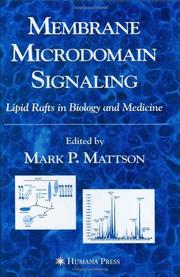| Listing 1 - 8 of 8 |
Sort by
|
Book
ISBN: 9780199652471 Year: 2015 Publisher: Oxford ; New York : Oxford University Press,
Abstract | Keywords | Export | Availability | Bookmark
 Loading...
Loading...Choose an application
- Reference Manager
- EndNote
- RefWorks (Direct export to RefWorks)
1: Introducing the cell: structure, molecular construction and communication strategies, Dr David Furness and Dr Carole Hackney 2: Studying cells: essential techniques, Dr Gavin Knight 3: Anatomy, embryology, and cell families, Dr Ian Locke and Dr. Joanne Murray 4: Blood cell genesis: red cell and white cell families, Dr Gavin Knight 5: Nerves: the cells of the central and peripheral nervous system, Dr Rosalind King and Richard Mathias 6: Lungs: the cells of the respiratory system, Behdad Shambayati 7: The alimentary canal, Tony Warford and Tony Madgwick 8: The cells and commensal bacteria of the alimentary canal, Dr Kathy Nye 9: The cells of the vascular and lymphatic systems, Dr Andrew Blann 10: Connective tissue, bones, cartilage and muscle, Dr Suha Deen 11: The cells of the liver, Anne Rayner and Dr Alberto Quaglia 12: The cells of the kidney, Guy Orchard, David Muskett and Brian Nation 13: Reproductive cells and gametogenesis, Andrew Evered and Behdad Shambayati 14: The endocrine system, Ms Judy Brincat 15: The cells of the skin, Dr Guy Orchard
Histology. Cytology --- cytologie --- Cells --- Cell Physiological Phenomena --- Cellules --- cytology --- Cytologie. --- Physiologie --- Physiologie. --- Cell Physiological Phenomena. --- moleculaire biologie --- Menselijk lichaam --- cytology.
Book
ISBN: 9781597453561 1588299481 9781588299482 9786612036330 1597453560 1282036335 Year: 2008 Publisher: New York, NY : Humana Press,
Abstract | Keywords | Export | Availability | Bookmark
 Loading...
Loading...Choose an application
- Reference Manager
- EndNote
- RefWorks (Direct export to RefWorks)
The epidermal growth factor (EGF) receptor and its downstream signal transduction networks have been implicated in the ontology and maintenance of tumor tissues, which has motivated the discovery and development of molecularly targeted anti-EGFR therapies. Edited by John Haley and William J. Gullick, EGFR Signaling Networks in Cancer Therapy, is separated into two sections. The first of which probes the molecular pathways and the intersection of signaling networks which are frequently deregulated in human cancers, with a view to describing EGF receptor in a tumor tissue specific context. Meanwhile, the second section illustrates the many ways in which EGF receptor contribute to abnormal survival and migration signaling in cancer cells and to epithelial to mesenchymal transition and metastasis. The book also describes the mitogenic, survival, adhesive and migratory pathways within a framework of interacting subsystems that contribute to the activity and physiological regulation of the receptor in normal and neoplastic tissues. Even though there is still much to learn, this volume explores this fascinating system with compelling information.
Medicine & Public Health. --- Oncology. --- Cancer Research. --- Medicine. --- Médecine --- Cancérologie --- Cancer --Chemotherapy. --- Cancer --Treatment. --- Cancer --- Receptors, Gastrointestinal Hormone --- Receptor Protein-Tyrosine Kinases --- Cell Physiological Processes --- Diseases --- Receptors, Growth Factor --- Biochemical Processes --- Receptors, Cell Surface --- Cell Physiological Phenomena --- Biochemical Phenomena --- Receptors, Peptide --- Protein-Tyrosine Kinases --- Chemical Processes --- Chemical Phenomena --- Membrane Proteins --- Phenomena and Processes --- Protein Kinases --- Phosphotransferases (Alcohol Group Acceptor) --- Proteins --- Amino Acids, Peptides, and Proteins --- Phosphotransferases --- Chemicals and Drugs --- Transferases --- Enzymes --- Enzymes and Coenzymes --- Receptor, Epidermal Growth Factor --- Signal Transduction --- Neoplasms --- Medicine --- Health & Biological Sciences --- Oncology --- Treatment --- Chemotherapy --- Chemotherapy. --- Treatment. --- Cancer therapy --- Cancer treatment --- Therapy --- Cancer research. --- Tumors --- Cancer research --- Clinical sciences --- Medical profession --- Human biology --- Life sciences --- Medical sciences --- Pathology --- Physicians --- Antineoplastic agents

ISBN: 9780387335353 0306478722 9780306478727 9786612823220 1282823221 0387335358 Year: 2006 Publisher: Georgetown, Tex. : New York : Landes Bioscience/Eurekah.com ; Kluwer Academic/Plenum Publishers,
Abstract | Keywords | Export | Availability | Bookmark
 Loading...
Loading...Choose an application
- Reference Manager
- EndNote
- RefWorks (Direct export to RefWorks)
Hematopoietic Stem Cells brings together articles covering the biology of hematopoietic stem cells during embryonic development, reporting particular aspects of fly, fish, avian and mammalian models. Thus, this book allows a comparative overview of hematopoietic stem cell generation in the different classes, emphasizing the conserved trends in development. This book culminates with state-of –the art knowledge on hematopoietic development in human species and discussions of the most recent breakthroughs with relevance to both researchers and clinicians.
Biomedicine. --- Biomedicine general. --- Human Genetics. --- Cell Biology. --- Developmental Biology. --- Medicine. --- Human genetics. --- Cytology. --- Developmental biology. --- Médecine --- Génétique humaine --- Cytologie --- Biologie du développement --- Hematopoiesis -- physiology. --- Hematopoiesis. --- Hematopoietic Stem Cells -- physiology. --- Hematopoietic stem cells. --- Hematopoietic stem cells --- Hematopoiesis --- Bone Marrow Cells --- Cell Differentiation --- Blood Physiological Processes --- Biology --- Biological Science Disciplines --- Stem Cells --- Genetics --- Hematopoietic Stem Cells --- Physiology --- Blood Physiological Phenomena --- Hematopoietic System --- Cells --- Natural Science Disciplines --- Cell Physiological Processes --- Disciplines and Occupations --- Anatomy --- Hemic and Immune Systems --- Circulatory and Respiratory Physiological Phenomena --- Cell Physiological Phenomena --- Phenomena and Processes --- Human Anatomy & Physiology --- Health & Biological Sciences --- Blood formation --- Hemopoiesis --- HSCs (Hematopoietic stem cells) --- Human physiology. --- Cell biology. --- Human Physiology. --- Blood --- Blood cells --- Bone marrow cells --- Hematopoietic system --- Multipotent stem cells

ISBN: 9780387699455 0387699449 9780387699448 1441924183 9786612823237 0387699457 128282323X Year: 2007 Publisher: New York, NY : Springer New York : Imprint: Springer,
Abstract | Keywords | Export | Availability | Bookmark
 Loading...
Loading...Choose an application
- Reference Manager
- EndNote
- RefWorks (Direct export to RefWorks)
About the Series: Advances in Biochemistry in Heath and Disease presents state-of-the-art discussions in cutting-edge biochemical research, offering exciting developments that impact healthcare and disease research. Volumes in the series focus on cross-disciplinary biomedical research and examine various topics in biochemistry, cell biology, molecular biology, and biomedicine. Mitochondria: The Dynamic Organelle Mitochondria: The Dynamic Organelle focuses on the function of the mitochondria and the organelle’s role in cellular pathology. While the traditional function of the mitochondria is metabolic, recent cutting-edge studies have uncovered a central role for mitochondria in cell signaling, cell survival and cell death. Mitochondria: The Dynamic Organelle presents examples of crosstalk between the mitochondria and the rest of the cell, which serve a regulatory role by modulating the levels of key metabolites, ions and oxidants or the activities of key rate-controlling enzymes. Detailed descriptions of the involvement of membrane receptors, channels, enzymes and metabolites in the cardioprotective mechanisms of the mitochondria are provided. This volume also discusses the death pathways that are initiated by the mitochondria. Novel therapeutic interventions are proposed which interfere with the death cascades, thereby rescuing the cell from mitochondria-linked apoptosis and necrotic oncosis. Mitochondria: The Dynamic Organelle is a timely contribution that addresses the reemergence of the mitochondria as a key player in cellular function and pathology. Key topics: Amino acid metabolism Carbohydrate and lipid metabolism Citric acid cycle regulation and metabolite transport Electron transport and oxidative phosphorylation Ischemic preconditioning Mitochondrial apoptosis Mitochondrial DNA damage Mitochondrial permeability transition Mitochondrial ion transporters Necrotic oncosis and mitochondrial dysfunction Peroxisome proliferators-activated receptors (PPARs) Mitochondria: The Dynamic Organelle is essential reading for researchers, molecular and cellular biologists, biochemists, physiologists and pathologists. About the Editors: Stephen W. Schaffer has been a professor of Pharmacology at the University of South Alabama, College of Medicine since 1988. He received training in mitochondrial function from the Johnson Research Foundation at the University of Pennsylvania. His research focuses on the effects of diabetes and angiotensin II on the heart, with a particular emphasis on the effects of mitochondrial DNA damage on the cardiomyocyte. He is a recipient of the Vincenzo Penagia Distinguished Scientist Award and is a fellow of the International Academy of Cardiovascular Sciences. He serves on the editorial board of Amino Acids and Molecular and Cellular Biochemistry and is editor of several books. M.-Saadeh Suleiman is currently a Professor of Cardiac Physiology at the Faculty of Medicine and Dentistry, University of Bristol. He joined the Department of Physiology in Bristol in 1988 and was one of the founders of the Bristol Heart Institute. His research is focused on myocardial protection including the role of mitochondria, and had significant impact on cardiac surgery where he was a member of the team that received the UK Hospital Doctor Award in 2005 for innovative surgery. He was a recipient of a Fulbright Fellowship and in 2003 was awarded a DSc in Physiology from the University of Bristol. He was elected twice to the executive committee of the British Society of Cardiovascular Research (1998-2004).
Life Sciences. --- Biochemistry, general. --- Molecular Medicine. --- Cell Biology. --- Developmental Biology. --- Life sciences. --- Medicine. --- Biochemistry. --- Cytology. --- Developmental biology. --- Sciences de la vie --- Médecine --- Biochimie --- Cytologie --- Biologie du développement --- Mitochondria. --- Mitochondrial pathology. --- Mitochondria --- Mitochondrial pathology --- Cell Death --- Cell Physiological Processes --- Subcellular Fractions --- Organelles --- Cytoplasmic Structures --- Cell Physiological Phenomena --- Cellular Structures --- Cytoplasm --- Phenomena and Processes --- Cells --- Anatomy --- Intracellular Space --- Biochemistry --- Biology - General --- Cytology --- Biology --- Chemistry --- Health & Biological Sciences --- Physical Sciences & Mathematics --- Mitochondrial disorders --- Chondriosomes --- Diseases --- Pathology --- Molecular biology. --- Cell biology. --- Metabolism --- Pathology, Cellular --- Cell organelles --- Protoplasm --- Disorders --- Development (Biology) --- Growth --- Ontogeny --- Clinical sciences --- Medical profession --- Human biology --- Life sciences --- Medical sciences --- Physicians --- Biological chemistry --- Chemical composition of organisms --- Organisms --- Physiological chemistry --- Cell biology --- Cellular biology --- Cytologists --- Composition --- Health Workforce --- Molecular biochemistry --- Molecular biophysics --- Biophysics --- Biomolecules --- Systems biology --- Medicine --- Biomedical Research. --- Developmental Biology and Stem Cells. --- Research. --- Biological research --- Biomedical research
Book
ISBN: 9781597454810 193411538X 9781934115381 9786612824029 1597454818 1282824023 Year: 2008 Publisher: [Totowa, N.J.?] : Humana Press,
Abstract | Keywords | Export | Availability | Bookmark
 Loading...
Loading...Choose an application
- Reference Manager
- EndNote
- RefWorks (Direct export to RefWorks)
Within the complex neuronal network of the nervous system, neuron-to-neuron communication occurs mainly through chemical synapses, where the presynaptic nerve terminal releases neurotransmitters that control the function of postsynaptic neurons by acting on postsynaptic receptors. Recent decades have brought groundbreaking new developments and a wealth of knowledge to this field. In Molecular Mechanisms of Neurotransmitter Release, leading experts provide concise, up-to-date information on all major molecular mechanisms involved, with complete background information and figures and diagrams to further elucidate key concepts or experiments. Comprehensive and cutting-edge, Molecular Mechanisms of Neurotransmitter Release is sure to provide a learning tool for neuroscience students, a solid reference for neuroscientists, and a source of knowledge for all those who have a general interest in the ever-evolving field of neuroscience.
Biomedicine. --- Neurosciences. --- Cell Biology. --- Neurobiology. --- Neurology. --- Human Physiology. --- Medicine. --- Human physiology. --- Cytology. --- Médecine --- Physiologie humaine --- Neurosciences --- Neurologie --- Cytologie --- Neurobiologie --- Neurotransmitters. --- Neural transmission. --- Synaptic Transmission --- Neurotransmitter Agents --- Physiological Effects of Drugs --- Signal Transduction --- Nervous System Physiological Processes --- Molecular Mechanisms of Pharmacological Action --- Electrophysiological Processes --- Physiological Processes --- Biochemical Processes --- Electrophysiological Phenomena --- Pharmacologic Actions --- Nervous System Physiological Phenomena --- Cell Physiological Processes --- Physiological Phenomena --- Musculoskeletal and Neural Physiological Phenomena --- Chemical Processes --- Biochemical Phenomena --- Chemical Actions and Uses --- Cell Physiological Phenomena --- Chemicals and Drugs --- Chemical Phenomena --- Phenomena and Processes --- Neuroscience --- Neurology --- Medicine --- Human Anatomy & Physiology --- Health & Biological Sciences --- Nerve transmission --- Nervous transmission --- Neurotransmission --- Synaptic transmission --- Transmission of nerve impulses --- Chemical nerve transmitters --- Nerve transmitter substances --- Neural transmitters --- Neurohumors --- Neuroregulators --- Synaptic transmitters --- Transmitters, Chemical nerve --- Transmitters, Synaptic --- Cell biology. --- Neural circuitry --- Neurophysiology --- Neurotransmitters --- Neurochemistry --- Neural transmission

ISBN: 9781588293541 1588293548 9781592598038 9786610358243 1280358246 159259803X Year: 2005 Publisher: Totowa, N.J. : Humana Press,
Abstract | Keywords | Export | Availability | Bookmark
 Loading...
Loading...Choose an application
- Reference Manager
- EndNote
- RefWorks (Direct export to RefWorks)
Lipid rafts-discrete regions in cell membranes that are rich in cholesterol and sphingolipids-are emerging not only as pivotal command and control centers for cellular signaling processes, but also as central to a wide array of human diseases, including immune disorders, diabetes, cardiovascular disease, and Alzheimer's disease. In Membrane Microdomain Signaling: Lipid Rafts in Biology and Medicine, multidisciplinary experts offer cutting-edge reviews of our current understanding of these membrane microdomains and their physiological and pathological roles. Here, readers will discover how lipid rafts change in cells over time and how they respond to various environmental signals, how cholesterol modulates the signaling function of lipid rafts, and how lipid rafts, the extracellular matrix, and the cell cytoskeleton structurally interact. Also described are the role of lipid rafts in learning, memory, and cancer, and as portals for endocytic uptake of an anticancer- and apoptotic alkyl-lysophospholipid. The authors also present emerging evidence that lipid rafts play critical roles in signaling pathways and the regulation of synaptic function in the nervous system, and that alterations in lipid raft metabolism are implicated in the pathogenesis of neurodegenerative disorders. They also describe techniques for the isolation of lipid rafts, the analysis of the lipid and protein components of lipid rafts, the imaging of lipid rafts in living cells, and the analysis of signal transduction in lipid rafts. Comprehensive and insightful, Membrane Microdomain Signaling: Lipid Rafts in Biology and Medicine offers researchers a multidisciplinary review of the latest basic, translational, and clinical research that promises to transform our understanding microdomain signaling mechanisms.
Membrane Microdomains --- Apoptosis --- Lipids --- Signal Transduction --- Synapses --- Membrane lipids --- Cellular signal transduction --- Lipides membranaires --- Transduction du signal cellulaire --- pathology --- physiology --- metabolism --- Apoptosis. --- Cellular signal transduction. --- Membrane lipids. --- Metabolism --- Physiology --- Lipid Metabolism --- Pathology --- Biochemical Processes --- Nervous System --- Cell Membrane Structures --- Metabolic Phenomena --- Chemicals and Drugs --- Cell Death --- Cell Physiological Processes --- Medicine --- Intercellular Junctions --- Biological Science Disciplines --- Phenomena and Processes --- Natural Science Disciplines --- Biochemical Phenomena --- Cell Membrane --- Cell Physiological Phenomena --- Chemical Processes --- Health Occupations --- Anatomy --- Cellular Structures --- Disciplines and Occupations --- Chemical Phenomena --- Cells --- Cytology --- Animal Biochemistry --- Human Anatomy & Physiology --- Biology --- Health & Biological Sciences --- Cellular information transduction --- Information transduction, Cellular --- Signal transduction, Cellular --- Life sciences. --- Cell biology. --- Life Sciences. --- Cell Biology. --- Bioenergetics --- Cellular control mechanisms --- Information theory in biology --- Membranes (Biology)

ISBN: 9781588291721 1588291723 9781592598519 9786610358199 128035819X 159259851X Year: 2005 Publisher: Totowa, N.J. : Humana Press,
Abstract | Keywords | Export | Availability | Bookmark
 Loading...
Loading...Choose an application
- Reference Manager
- EndNote
- RefWorks (Direct export to RefWorks)
Cell death, or apoptosis, plays an important role in biological processes and disease and offers special opportunities to develop new therapies for cancer, autoimmune disease, stroke, heart attack, and Alzheimer's disease. In Death Receptors in Cancer Therapy, leading physician-scientists and basic researchers review in depth our latest understanding of the molecular events that regulate cell death, illuminating those molecules that provide targets for agonists or antagonists designed to modulate death signaling for therapeutic purposes. The authors focus on the extrinsic system of death receptors, their regulation and function, and their abnormalities in cancer. Topics of particlar interest include resistance to apoptosis, TRAIL signaling, death receptors in embryonic development, mechanisms of caspase activation, and death receptor mutations in cancer. Additional chapters address death signaling in melanoma, synthetic retinoids and death receptors, the role of p53 in death receptor regulation, immune suppression of cancer, and combination therapy with death ligands. Authoritative and up-to-date, Death Receptors in Cancer Therapy offers a timely compendium of cell death signaling pathways for those seeking either a basic understanding of apoptosis or the knowledge needed to develop new therapeutics that will activate or block death signaling in disease.
Neoplasms --- Cell Death --- Gene Therapy --- Receptors, Tumor Necrosis Factor --- Apoptosis --- Cell receptors --- Cancer --- Cellular signal transduction --- Apoptose --- Récepteurs cellulaires --- Transduction du signal cellulaire --- immunology --- therapy --- methods --- Molecular aspects --- Aspect moléculaire --- Kanker --- Kanker ; moleculaire aspecten --- Apoptosis. --- Cancer -- Molecular aspects. --- Cell receptors. --- Cellular signal transduction. --- Biological Therapy --- Genetic Engineering --- Diseases --- Investigative Techniques --- Cell Physiological Processes --- Receptors, Cytokine --- Cell Physiological Phenomena --- Receptors, Immunologic --- Analytical, Diagnostic and Therapeutic Techniques and Equipment --- Genetic Techniques --- Therapeutics --- Receptors, Cell Surface --- Phenomena and Processes --- Membrane Proteins --- Proteins --- Amino Acids, Peptides, and Proteins --- Chemicals and Drugs --- Methods --- Medicine --- Biology --- Health & Biological Sciences --- Cytology --- Oncology --- Molecular aspects. --- Cellular information transduction --- Information transduction, Cellular --- Signal transduction, Cellular --- Cell membrane receptors --- Cell surface receptors --- Receptors, Cell --- Medicine. --- Oncology. --- Medicine & Public Health. --- Tumors --- Clinical sciences --- Medical profession --- Human biology --- Life sciences --- Medical sciences --- Pathology --- Physicians --- Bioenergetics --- Cellular control mechanisms --- Information theory in biology --- Binding sites (Biochemistry) --- Cell membranes --- Cell death

ISBN: 9781588294999 1588294994 9781597450249 1617376027 9786610358526 1280358521 1597450243 Year: 2006 Publisher: Totowa, NJ : Humana Press : Imprint: Humana,
Abstract | Keywords | Export | Availability | Bookmark
 Loading...
Loading...Choose an application
- Reference Manager
- EndNote
- RefWorks (Direct export to RefWorks)
The recent discoveries that established histone acetylation as a key regulatory mechanism for gene expression triggered a wave of interest in histone posttranslational modifications and led to the development of novel anticancer agents now in clinical trials. In Histone Deacetylases: Transcriptional Regulation and Other Cellular Functions, a panel of leading investigators summarizes and synthesizes the new discoveries in this rapidly evolving field. The authors describe what has been learned about these proteins, including the identification of the enzymes, the elucidation of the enzymatic mechanisms of action, and the identification of their substrates and their partners. They also review the structures that have been solved for a number of enzymes-both alone and in complex with small-molecule inhibitors-and the biological roles of the several histone deacetylase (HDAC) genes that have been knocked out in mice. Authoritative and state-of-the-art, Histone Deacetylases: Transcriptional Regulation and Other Cellular Functions constitutes a first landmark of what has been accomplished so far and sets a clear agenda for the full definition of HDAC roles in biology and disease in the years to come.
Histone Deacetylases --- Cell Cycle --- Enzyme Repression --- Neoplasms --- Sirtuins --- Histone deacetylase. --- Cell cycle. --- Enzymes. --- Cancer --- Histone désacétylase --- Cycle cellulaire --- Enzymes --- physiology. --- drug effects. --- antagonists & inhibitors. --- drug therapy. --- Chemotherapy. --- Chimiothérapie --- Cancer -- Chemotherapy. --- Histone deacetylase --- Cell cycle --- Cell Physiological Processes --- Gene Expression Regulation, Enzymologic --- Enzyme Inhibitors --- ADP Ribose Transferases --- Amidohydrolases --- Group III Histone Deacetylases --- Biological Science Disciplines --- Intracellular Signaling Peptides and Proteins --- Diseases --- Therapeutics --- Analytical, Diagnostic and Therapeutic Techniques and Equipment --- Natural Science Disciplines --- Molecular Mechanisms of Pharmacological Action --- Pentosyltransferases --- Proteins --- Gene Expression Regulation --- Cell Physiological Phenomena --- Hydrolases --- Disciplines and Occupations --- Glycosyltransferases --- Amino Acids, Peptides, and Proteins --- Pharmacologic Actions --- Phenomena and Processes --- Genetic Processes --- Transferases --- Chemical Actions and Uses --- Enzymes and Coenzymes --- Genetic Phenomena --- Chemicals and Drugs --- Drug Therapy --- Histone Deacetylase Inhibitors --- Physiology --- Human Anatomy & Physiology --- Medicine --- Health & Biological Sciences --- Animal Biochemistry --- Oncology --- Chemotherapy --- Biocatalysts --- Ferments --- Soluble ferments --- Mitotic cycle --- Nuclear cycle (Cytology) --- Medicine. --- Cancer research. --- Biomedicine. --- Cancer Research. --- Antineoplastic agents --- Catalysts --- Enzymology --- Biological rhythms --- Amidases --- Treatment --- Oncology. --- Tumors --- Cancer research
| Listing 1 - 8 of 8 |
Sort by
|

 Search
Search Feedback
Feedback About
About Help
Help News
News